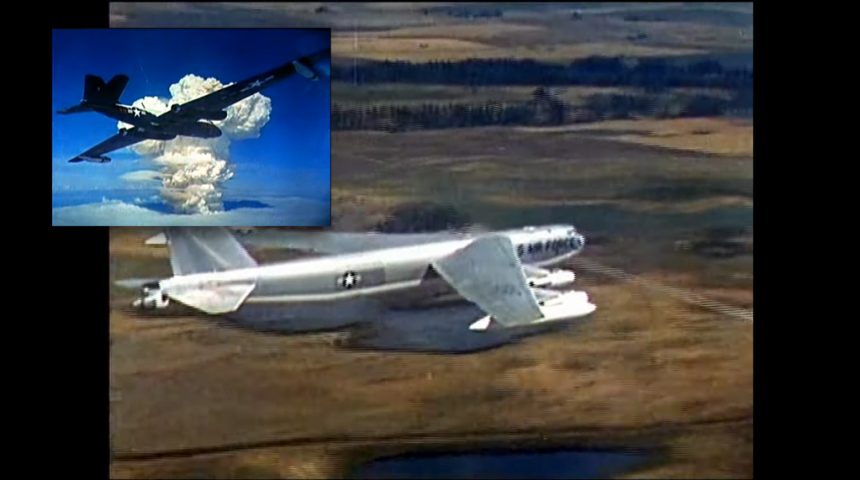A 1960 Strategic Air Command training video familiarized B-52 crews with the devastating effects of nuclear weapons and how to navigate through a nuclear battlefield.
The U.S. National Archives and Records Administration (NARA) recently declassified some very interesting training films and film reports that the Strategic Air Command prepared in the 1960s to prepare bomber pilots and crews for a potential nuclear war. Among these there is the United States Air Force Training Film 5363, “Nuclear Effects During SAC Delivery Missions,” made in 1960 and which kept its secret classification until now.
The purpose of Training Film 5363 was to familiarize SAC pilots and crew members with the devastating effects of nuclear weapons detonations and the detailed plans that were developed so the crews could evade the dangers of a nuclear battlefield and return home after completing their mission. These plans were among the contents of the “Combat Mission Folders,” which included guidance needed to reach targets and return to base safely and were assigned to each nuclear-armed bomber on alert duty.
Back in the day, B-52s with nuclear weapons on board were on alert and ready to launch in just 15 minutes from the alarm, while others performed airborne alert missions as part of Operation Chrome Dome. These bombers on high alert were meant to perform retaliatory nuclear strikes in the event the Soviet Union attacked the United States. The fact that the training film was declassified as Russia continuously threats the use of nuclear weapons, as retaliation for the Western support to Ukraine since the invasion started last year, is worth of remark.
The film begins with a B-52 flying a sortie of the Emergency War Order, launched under Positive Control and on its way to the “go/no-go” position, but without the crew knowing if this is a real mission or an exercise until they get there. Before eventually going in, however, the narrator explains that, while they know that the mission can be successfully accomplished as it was carefully planned and reviewed by highly qualified combat planners and they flew countless profile missions, they need to know the nuclear effects of a detonation.
The narrator then takes the viewers trough the basics of a nuclear detonation’s thermal, blast and radiation effects and the efforts that the U.S. Air Force had taken to prepare the crews for situations where they might experience them. In fact, the central part of the film covers the effects of nuclear explosions of both aircraft and crew and the measures taken to minimize crew exposure, like carefully planned routes that created a safe distance between the bomber and the detonation of their weapon and the detonations caused by other SAC bombers operating in the same area.
The film goes on with an overview of the multiple atmospheric nuclear tests performed by the US, from Crossroads in 1946 to Hard Tack in 1958, which increasingly included efforts to measure the effects of the tests on aircraft and structures, both in the air and on the ground, and which often used drones to measure radioactivity in the air, as well as B-47 Stratojet bombers with air sampling equipment. Together with these tests, research by university and Air Force scientists helped refine SAC operational procedures.
This huge quantity of data flows right into the planning cells of SAC, numbered Air Forces and Wings to carefully plan the missions of the EWO in accordance with the target assignment by the Joint Chief of Staff to SAC. The detailed plans and the “overwhelming mass of facts and figures” required to safely perform the mission are then stored in the Combat Mission Folder stored on the aircraft.
The film then returns to the B-52 approaching the turnaround point, when then a radio message from SAC comes in: “Sky King. Sky King. This is Migrate. This is Migrate. Do not answer. Break. Break. Alpha Sierra Foxtrot Juliet Oscar Papa Mike Tango. Break. Go-Code.” The crew scrambles to verify the code and discover that this is the go code for a real mission: “Pilot to crew. We checked the go code and verified it. This is it. We’re going in”.
After a very brief moment of disbelief, the crew members get down to business and prepare the aircraft for the nuclear strike mission as they are about to cross the H-Hour Control Line on the way to their assigned target in the Soviet Union. As they navigate towards the target, the crew experience the shockwave from another nuclear bomb dropped in the vicinity of their route, before a low-altitude flight over lakes, mountains, forests and fields to avoid Soviet air defense missiles.
Once they get few miles from the target, the bomber performs a pop-up maneuver, drops the bomb and descends again to low altitude and high speed to create a safe separation distance from the target. Once the bomb detonates, a battle damage assessment is performed and the B-52 returns to the “safe side of the HHCL, but not before flying in the contaminated cloud of a bomb dropped 30 minutes earlier to avoid flying in the explosion of a multi-megaton bomb scheduled at the time would pass over the area.
The narrator concludes the film with a dramatic statement which reflected the tension of the potential nuclear war that was expected to happen at any time during the Cold War: “This could happen. If this nightmare situation ever materializes into grim reality, you may have a real bear by the tail, but at least you are assured of escaping from the nuclear effects of our own weapons.”
This is just one of the videos that were recently declassified, together with a film specifically talking about the Combat Mission Folders, multiple semi-annual reports and a training film on the Tactical Operations Rooms of the Ballistic Missile Early Warning System. You can find out more on National Security Archive, together with the videos and detailed descriptions.









